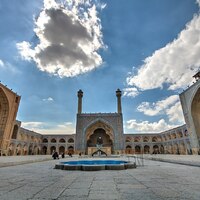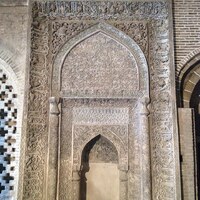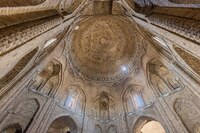Great Mosque of Isfahan
Date:
Built in the ninth century; major Seljuq interventions beginning in 1086
Location or Findspot (Modern-Day Country):
Iran
Description:
In the ninth century (840–41), the Abbasids built the congregational mosque of Isfahan. In 1086, the Seljuq vizier Nizam al-Mulk (r. 1064–92) tore down twenty-four of its columns to insert a freestanding pavilion in front of the mihrab, possibly as his private prayer area. A year later, Nizam al-Mulk's rival Taj al-Mulk built the second domed chamber on the opposite (north) side of the mosque. At a later date (possibly after a fire in 1121), an iwan replaced the columns between the courtyard and Nizam al-Mulk's south dome. This was an architectural feature that had existed in Sasanian architecture and that the Seljuqs introduced it into mosques. Three complementary iwans then followed, built into the other three courtyard facades. This arrangement of four iwans and a dome became common among mosques in Iran by the first half of the twelfth century.
Sultan Uljaytu, who promoted the Ilkhanids' ties to past empires and earlier works in the Compendium of Chronicles and in his mausoleum at Sultaniyya, also added a prayer room with a stuccoed mihrab next to the west iwan of the Great Mosque at Isfahan. Ibn Battuta reports that Uljaytu's conversion to Shi'i Islam in 1309, following a visit to the shrine of 'Ali, caused riots in Sunni Isfahan; nevertheless, the new mihrab features multiple Arabic inscriptions about Muhammad and 'Ali around a central Qur'anic verse (4:49) about obedience to those in authority. The likely head of the stucco workshop, named Haydar, signed the mihrab in 1310. He sketched the complicated layering of script and vegetal background on the wet plaster before carving into it. Only traces of its original polychromy survive; the paint was applied after the plaster had dried and therefore did not bind with the sculpted surface. Contemporary sources disagree about whether Uljaytu eventually returned to Sunni Islam, but the mihrab was not changed with its patron's shifting allegiances.
Sultan Uljaytu, who promoted the Ilkhanids' ties to past empires and earlier works in the Compendium of Chronicles and in his mausoleum at Sultaniyya, also added a prayer room with a stuccoed mihrab next to the west iwan of the Great Mosque at Isfahan. Ibn Battuta reports that Uljaytu's conversion to Shi'i Islam in 1309, following a visit to the shrine of 'Ali, caused riots in Sunni Isfahan; nevertheless, the new mihrab features multiple Arabic inscriptions about Muhammad and 'Ali around a central Qur'anic verse (4:49) about obedience to those in authority. The likely head of the stucco workshop, named Haydar, signed the mihrab in 1310. He sketched the complicated layering of script and vegetal background on the wet plaster before carving into it. Only traces of its original polychromy survive; the paint was applied after the plaster had dried and therefore did not bind with the sculpted surface. Contemporary sources disagree about whether Uljaytu eventually returned to Sunni Islam, but the mihrab was not changed with its patron's shifting allegiances.
Relevant Textbook Chapter(s):
5,
7,
9
Repository and Online Resources:
• Visit the website for this mosque on UNESCO's World Heritage List.
Image Credits:
Wikimedia Commons, Navid Jamali








